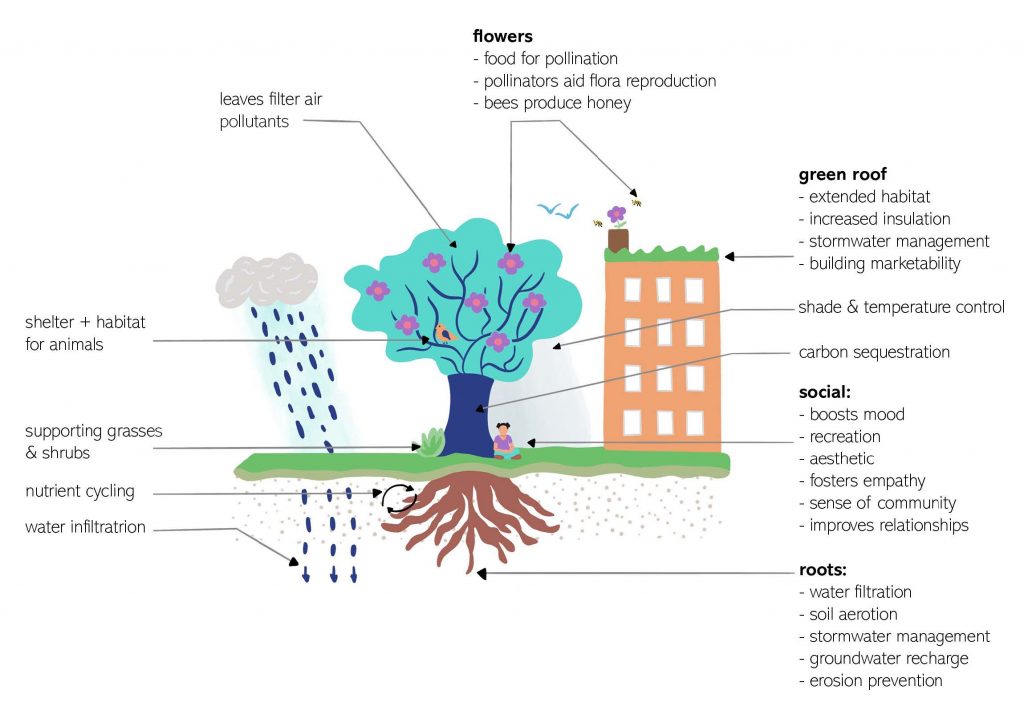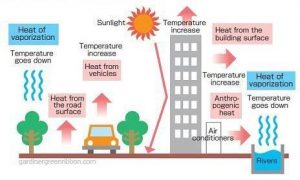Lungs of the world:
Make trees and forests part of your teaching
The importance of forests and the benefits of single trees in the cities are still too vaguely understood by the urban inhabitants, students and teachers alike.
We hope the compilation of this material lowers the threshold to make trees and forests part of your teaching, across subject lines. It is of utmost important to help the students of today recognize the importance of trees in our immediate living sphere.
We invite you to teach your students about urban trees and forests in a manner that allows them the easy integration and application of the learnt material, and finally, inspires your students to notice, value and protect the urban trees and forests now and in the future for the health of our planet.
Please wait while flipbook is loading. For more related info, FAQs and issues please refer to DearFlip WordPress Flipbook Plugin Help documentation.
More translations of the lessons coming soon
Further reading
Almost everything you need to know about the importance of trees and urban forests. Background information to support the lessons.
ECOSYSTEM SERVICES OF A TREE
This section is connected to exercise 1: Noticing trees in cities
The most obvious benefit of trees for the planet is often identified by their photosynthesizing character. As trees breathe in carbon dioxide, they produce fresh oxygen and convert the captured CO2 to glucose and use it to grow (carbon sequestering) As a by-product, water is released into the atmosphere.
However, next to their oxygen producing capacity, trees make life on Earth livable and therefore, the ecosystem services, i.e the services they provide us that enable and make our life on this earth possible and enjoyable, might more accurately be called “life supporting services”.
Ecosystem services provided by trees and urban forests can be summarized as:
- Regulating temperatures through evapotranspiration
- Providing shade and wind shield
- Filtering air pollutants through capturing fine particles on leaves
- Sequestering, i.e., binding carbon from the air to use for tree growth
- Managing and filtering rainwater, infiltrate stormwater, groundwater recharge
- Stabilizing soils and maintain soil health through e.g., soil aeration, cycling nutrients across soil
- Prevent erosion by holding onto soil particles
- Providing food and shelter for living organisms, including humans
- Improving urbanites’ well-being by facilitating possibilities for contact with nature, and providing aesthetic pleasure
HOW TREES MAKE OUR CITIES LIVABLE
This section connects with exercise 1: Noticing trees in cities and exercise: 14 Water cycle in urban forests
The UN estimates that by 2050 about 70 % of the world’s population will be living in cities. With high population density and high energy consumption, cities also produce most of the pollution in the world. This pollution translates to material, light, sound and air pollution too.
Due to the lack of green surfaces, cities have become hot spots during heatwaves and unbearable to especially to their most vulnerable inhabitants. Many surfaces in the cities are impermeable, which causes problems in different areas. Stone, cement, and concrete all take up and hold a lot of heat as opposed to permeable surfaces that tend to also contain some moisture in them. Due to the moisture, they heat up slower.
Heat island effect refers to an urban or metropolitan area that is significantly warmer than its surrounding rural areas. This phenomenon is clearest during the summer and winter. The main cause of the urban heat island effect is caused by the land surfaces that have been converted from natural to paved. Waste heat generated by energy usage also contributes to heat island effect.
Planting shrubs, grass and trees can lower surface and air temperatures in the city through evapotranspiration and the shade provided by trees.
Evapotranspiration means evaporation and plant transpiration of humidity to the atmosphere from the leaves of plants. This way trees and vegetation can be used as a mitigation strategy to fight excess heat in the city, for example around buildings or to shade pavement in parking lots and on streets. Planting deciduous trees or vines to the side of the building mostly in the sun can also help to cool a building. This natural air cooler reduces energy usage that would be needed for air conditioning. It also reduces the need for energy use, improves air quality and lowers greenhouse gas emissions.
INTERCEPTION – Rain falls on the tree’s leaves, branches and trunk. The trunk being absorbs this to some extent and evaporates some of it into the atmosphere. The rest falls through to the ground, but slower than it would otherwise helping to reduce “peak flows” during heavy rain. It mitigates soil erosion.
INFILTRATION – Water that falls through the tree canopy (i.e the highest branches of the tree) soaks into the ground and gets absorbed by the tree’s roots. Trees make it possible for the soil to store even more stormwater, as the trees roots soak up the water. As the roots grow, they break up compacted soil, which allows water to more easily move downward into the groundwater table.
TRANSPIRATION – The tree uses water out of the ground as fuel for photosynthesis. Then it releases it back into the atmosphere as water vapor. This helps to cool the air and reduce high temperatures in the summer.
EVAPORATION – Water evaporates, i e moves back into the air from sources such as the soil, canopy interception, and waterbodies.
EVAPOTRANSPIRATION – i.e. the sum of evaporation and plant transpiration from land and water surfaces to the atmosphere.
WATER CYCLE IN THE CITY
This section connects to exercise: 5 Forest models
In a large city, a single tree can capture and redistribute an average of 6500 liters of rainwater each year. Without city trees, all of the water would fall to the ground, and much of it would become runoff. During a heavy rainstorm, the sewers could overflow from pollutant carrying water running too fast on the paved streets into nearby waterbodies and overflowing the city. But, with the help of trees, the water would be captured, stored and re-used as part of the natural water cycle, soaked up by trees and returned to the atmosphere.
In a large city with estimated 200 000 street trees, 400 000 park trees and hundreds of thousands of privately owned trees, it is an impressive amount of water that gets captured by the urban tree canopy. The more trees we add to our landscape, the less pollution will flow to our waters.
On the other hand, there often is a lack of water for long periods, because the city with paved surfaces can’t soak up the water. Trees and green surfaces are part of the solution for this problem. Plants and trees hold water for a long period of time. More green means less flooding, less excess heat and less droughts. In addition, greener cities are nicer to live in as they are more pleasing to the eye. A city needs paved surfaces to function, but many opportunities exist to make a city greener. For example, it is a good option for streets and parking lots to build them out of water permeable stones.
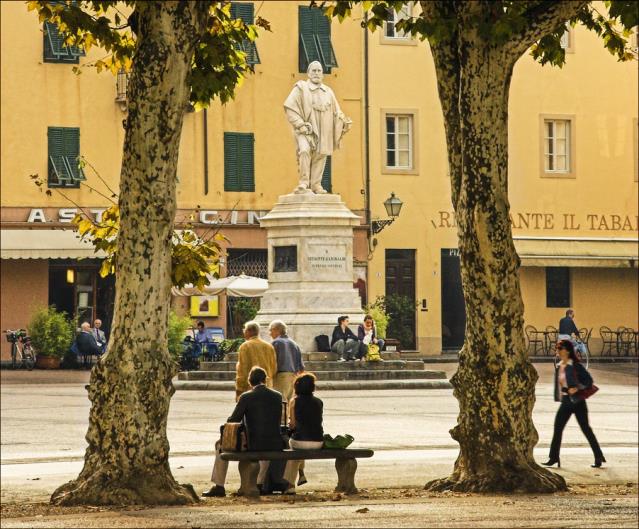
Citizens themselves can also play a role in storing water in the city. They can turn their front and back yards into gardens by removing pavement. Individual house owners without a garden can also contribute to a green environment. They can opt for ‘green roofs’ or to having a ‘pavement garden patch’. Some cities even encourage such citizen initiatives by granting subsidies for them. In the exercise ‘Forest models’, students will pour water through different substances. The results will be that the green substance holds up the most water. The other substances will either allow most of the water to flow through lose stones and sand) or retain the water on top of the surface without it infiltrating the material (clay).
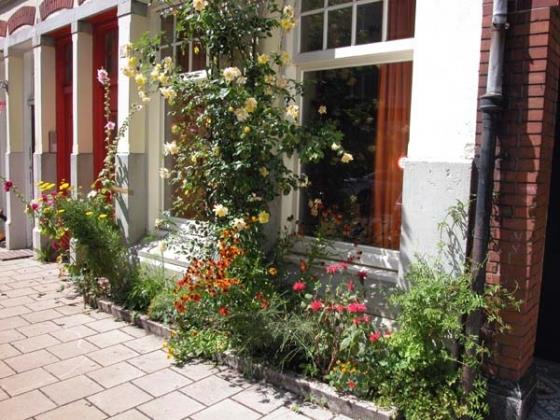
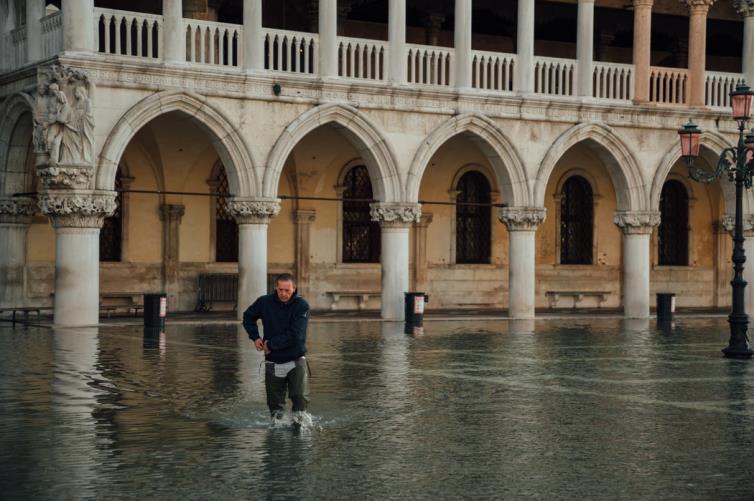
WEB OF LIFE
This connects to exercise 7 Web of life, 10 Habitat map
If we think about which trees or plants to choose for, we should pay attention to how they contribute to biodiversity. Biodiversity stands for the number of different species, as well as the variety (e.g., age, subtype) within a species on a certain area. Biodiversity is often used as a criterion to measure the health of a biological system. The more biodiverse an area is, the stronger and healthier the ecosystem. Biodiversity makes an area stable and healthy, affects the health of the planet and therefore has a direct impact on our lives.
Unfortunately, due to human activities that threaten biodiversity, we are facing a biodiversity crisis. Many species have gone extinct (lost their last living individuals), and many species exist in such low numbers that they will likely not survive a hit by a health threat or natural disaster. As all life on the planet is connected in the web of life, biodiversity crisis includes humans as well, even if the human species is not threatened by extinction now.
Though biodiversity is threatened, in many cities in the world biodiversity in the city is being promoted. Many different plants, trees and shrubs in the city will stimulate biodiversity. The more variation in vegetation, the more variation it will attract in the animal life. A wide range of pollinating insects and many different plants will be a food source for birds and other animals. Protecting biodiversity starts with knowing the diversity of species that are living among us.
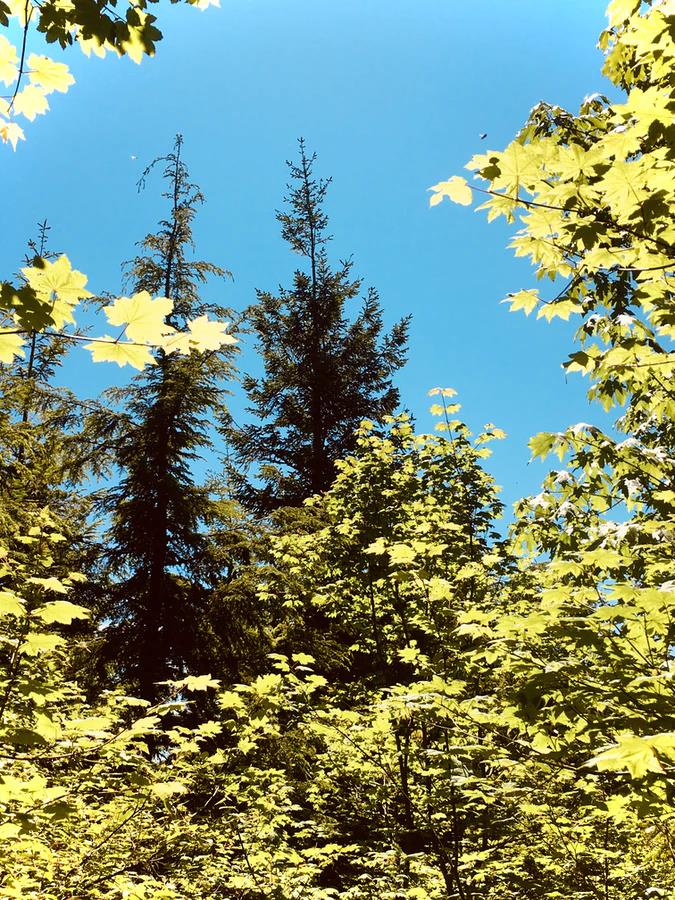
NATIVE AND NON NATIVE SPECIES
This section connects to exercise 2 resistant trees, 4 it all starts from a seed, 7 Web of life, 10 habitat map, 13 (non)-native species
A habitat is the place or environment where a plant or animal naturally or normally lives and thrives. It provides the animal with food, water and shelter.
There are many different sorts of habitats around the world from forests to grasslands and from mountain slopes to deserts all with their own distinctive characteristics. A city is a habitat that is home to many different animals, plants and people. A lot of them live very close to each other making the city a very special, always changing habitat. Some species do well in the altered and human managed habitats, while others are threatened due to decreased space, increased competition from other species, and changed water and sunlight conditions.
Not all trees are equally resistant to the changing environment. Some native species are experiencing difficulties to survive due to the changes in the climate they have been thriving in. At the same time, non-native species better suited for the new temperatures are finding their way into new territories often due to human activities (travelling, escaping from gardens…) and then thriving in new latitudes. This creates a threat to native forests as non-native species become invasive and start to overpower the competition for space. The forest’s character changes.

So why should we promote the native species if some non-native species do much better in the changing climate? Native species are less invasive, and therefore more conducive to biodiversity. Mostly they do better, i.e., are more resilient in the ecosystem in which they evolved in. They also add greater wildlife benefits, i.e., play a bigger role for the wildlife in the ecosystem for the other animals in it, be it through bearing fruit and nuts which can be eaten by species living in the same ecosystem, offering nesting spaces, etc.
Securing a diverse mix of species will maximise the benefits of trees. It will also help with conservation efforts such as insect and wildlife initiatives by providing more diverse habitats for more diverse species. In addition, species diversity ensures that an ecosystem, e.g., an urban forest, will be better prepared for pests and diseases which could wipe out an entire species of trees in one area and therefore cause severe changes in the wellbeing of all species within the ecosystem.
MATURE TREES IN THE CITY
This section connects to Exercises 1 Noticing trees and exercise and 2 Resistant trees
Unlike people, trees can grow to become as old as thousands of years old. Additionally, unlike people, trees do not age fast, nor do they grow with all their organs intact. In fact, they recreate the materials they need for survival every year, i.e., leaves, seeds and flowers. It is rare for a tree to die of old age alone. Instead, it is the exposure to the stress of wind, disease, insects, pollution, soil erosion, soil compaction, weather and people that will most likely cause it to deteriorate and die off. Research indicates that younger forests are better at storing carbon. One reason that might explain this is that newly deforested areas are open and sunny and are easily recolonized by fast growing species. These plants are able to extract carbon from the air and incorporate it into their biomass more quickly than mature trees that must compete with more neighbours and less sunlight.
Old trees are often (but not always) larger in size. Large trees are excellent filters for urban pollutants and fine particulates. They absorb pollutant gases (such as carbon monoxide, nitrogen oxides, ozone and sulphur oxides) and filter fine particulates such as dust, dirt or smoke out of the air by trapping them on leaves and bark. Mature trees regulate water flows and play a key role in preventing floods and reducing the risk of natural disasters. A mature evergreen tree, for instance, can hold on to more than 15000 liters of water per year.
Especially large, old trees are used by many animals for nesting, resting and for places from which to hunt or capture prey. For example, some large birds of prey use snags or dead branches to get a clear view of potential prey when hunting. Also, smaller birds catch flying insects directly out of the air using the large branches high up to attack. In the end, the old tree turns into organic matter and returns to being part of the earth. But before that, it is the nutrition for many decomposers, such as polypores and some insects. In fact, fungi exist in its own kingdom apart from plants and animals and forms often a bond with the roots of trees.
Fungi is present throughout the lives of trees, first by sustaining them by bringing them nutrients and water from further away through the mycorrhiza networks under ground, and later, as the tree becomes wounded or weakens due to very old age, a polypore starts to decompose the still standing tree. Therefore, trees and fungi have a very special life long connection.
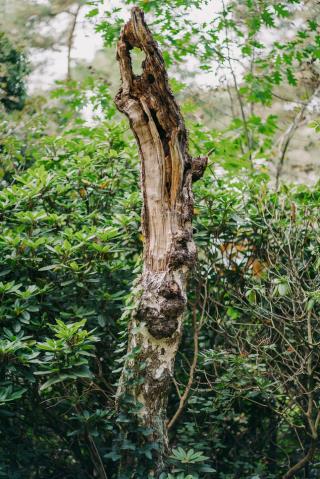
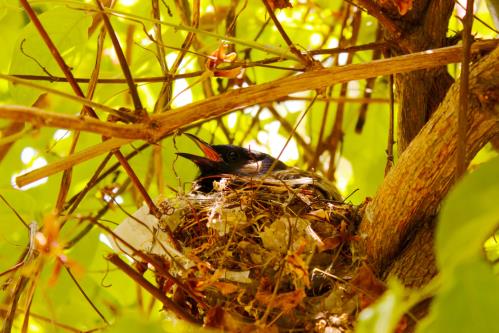
Even when the tree dies, it is still very useful for some species, such as woodpeckers that use dead trees to drill for food and to nest in cavities excavated in snags (or dead parts of living trees). Other birds use the branches of mature trees for nests. As trees grow older, their branches become large and begin to grow horizontally rather than vertically, creating attractive platforms for nest construction. Some mammals such as squirrels and raccoons use dead trees as nesting sites. Logs are useful for snakes that like to sun themselves in summer to help regulate their internal temperature as well as providing them with a place to hide, find a meal or (for some) hibernate for the winter. Other amfibians such as salamanders use rotting logs and stumps as both shelters and food sources. Without big old trees many animals would suffer or perish. Smaller trees simply cannot play all the different roles the mature trees can as they have fewer dead branches and flowers, less nectar, peeling bark and woody debris compared with large, established trees. Tree hollows that are important nesting places for birds like owls, can take over 200 years to form.
Regardless of their importance, we keep losing old trees in the cities to make way for urban expansion. Property owners and city officials are worried for damage caused by breaking trees due to storm or heavy winds. Due to lack of understanding of the vital services an old or dead tree has to offer to its surroundings, old trees are quickly removed from making way for younger trees, which are also important, but become even more important as they age.
AIR QUALITY IN A GREEN CITY
This section connects to exercise 8 The air we breathe
Unlike people, trees can grow to become as old as thousands of years old. Additionally, unlike people, trees do not age fast, nor do they grow with all their organs intact. In fact, they recreate the materials they need for survival every year, i.e., leaves, seeds and flowers. It is rare for a tree to die of old age alone. Instead, it is the exposure to the stress of wind, disease, insects, pollution, soil erosion, soil compaction, weather and people that will most likely cause it to deteriorate and die off. Research indicates that younger forests are better at storing carbon. One reason that might explain this is that newly deforested areas are open and sunny and are easily recolonized by fast growing species. These plants are able to extract carbon from the air and incorporate it into their biomass more quickly than mature trees that must compete with more neighbours and less sunlight.

In addition to the heat island effect and the risk of flooding, there are other factors that threaten a healthy lifestyle of the modern city dweller. However, the decreased quality of air and high levels of air pollution is possibly the greatest threat for our health. Nowadays, small particle pollution is regarded as the worst contamination in our urban atmosphere. A recent study by the University of Utrecht revealed that air pollution caused by small particles measuring less than 10 micrometres has a greater effect on our wellbeing than we assumed thus far.

Why is it so important to breathe clean air? Air pollution increases the chance on cardiovascular diseases, strokes and certain forms of cancer. It can also cause or worsen asthma and chronic bronchitis. Air pollution also causes people to die prematurely in many cities around the world. Air pollution is called an invisible killer.
But trees, shrubs, plants and even mosses help filtering harmful small particles from the air. Busy streets, but also parks and green belts near playgrounds, day care centres and schools will become cleaner if trees and shrubs can bind small particles and nitrogen dioxide that is also another effect of burning fuels. Of course, this will have to go hand in hand with decreasing pollution.
How do you know you are at a place where there is no/not much air pollution? Notice the size of the street and the kind of vehicles driving there. Also, the weather conditions may affect this: wind makes the air move and lessens the effect of air pollution.
DR FOREST AT YOUR SERVICE
This section is linked to exercise 3 Patterns in nature, 6 Forest for rest, 11 Peace of mind in the city
Not only are trees and plants wonderful to look at in a city, a green view is so much more than just decoration. A green environment improves the quality of life. Research shows that patients recover much faster in a green environment, residents of green neighbourhoods make less use of healthcare services, and employees of companies surrounded by greenery, feel much happier. In addition, a city park will encourage people to exercise and relax there, which will improve their health.
If you are feeling nervous, worried or stressed, what helps you to calm down in a situation like that? When thousands of people were asked this, almost all of them answered, “spending time in nature”. Research reveals that natural environments parks, forests, meadows etc. can reduce our stress levels, stop us from thinking the worrisome thoughts, and make us better able to focus our tasks requiring our attention. In addition, spending time out in nature, makes us feel like we have more energy.
It is maybe hard to believe, but before we built cities, apartment buildings, had TVs, internet connections and all other comforts, human beings lived close to nature. This made us very attuned to nature. You can think of it as birds being able to navigate from Africa to Europe every spring. Similarly, we evolved in connection with nature and her cycles.
But even after years and years of living in the cities, our bodies have not changed that much. We will react to nature in a way that our bodies remember That is why when we get stressed in a built environment with all the flashing lights, sharp corners and sudden noises, we restore when we go out into a natural environment with the dominating green colour, sounds of birds, wind and water, as well as the fresh air and the fresh nature smells that are familiar to us.
Researchers have noticed that when we look at or enter a natural environment, majority of us starts to calm down right away in our bodies. Familiar, non-threatening natural sounds in nature or recorded will provide our nervous system messages that help us to relax. This works the same with pleasant, familiar nature smells around us.
After spending some time in nature, we notice that the thoughts do no longer race in the same circle, but they have calmed down. There is more space in our heads and more clarity. People have been found to be able to focus better after spending just 20 minutes in nature. That is the reason why it is important to get outside to look at trees and plants during the recess between classes. Especially for children and youth with ADHD the time spent in nature increases their ability to pay attention later.
Finally, being outdoors is good for our immunity. Immunity is out internal army that makes sure we stay healthy and do not get sick from outside forces. Nature helps us to become stronger as our levels of vitamin D increase when we are exposed to the healthy doses of sunlight.
Another way our immunity gets strengthened in nature is by getting in contact with the microbes that are in nature, especially in the soil. Of course, in the city you will also share the space with many people as well as their pets, so you should pay attention to not be exposed to deleterious microbes. However, e.g., touching the clean soil in the garden, running your hands through the meadow full of wildflowers, or breathing in the compounds floating around close to trees or the urban forest air, can have beneficial effects on our health to a degree that we are only starting to understand through scientific research.
This section is connected to exercise 3 Patterns in nature, and 7 Forest for rest
The reasons why we calm down in natural surroundings can be partially explained by the colour green which effects our brain in a calming way. It is the same mechanism as with the colour red, which, is why in the old bull fighting tradition they use the red cloth, which together with the waving movement can aggravate the bull to attack. Green colour has an opposite, calming effect on us. For people who do not see the colour green, this cue will be not registered, but there are other cues which make us calm down in nature. For instance, the branches of a tree form similar patterns that repeat themselves in different scales from large to small.
This rhythmic form language of nature is called fractal patterning and nature is full of examples of it: snowflake, trees branching, lightning, and ferns. Furthermore, it has been found that there is a neural mechanism in our brains that can explain why simply viewing nature make us calm down. At first glance, this physical “language” of nature seems incredibly complex, detailed and complicated to read, but actually the opposite is true. For our brain, fractals are easy to read and moreover, our brains find fractals particularly pleasant and soothing to look at.
COLOURS OF THE FOREST
This section is connected to exercise 3 Patterns in nature and 14 Colours of the forest
Those living in regions of the globe where they can experience 4 seasons, often report autumn to be their favourite season due to the beautiful autumn foliage, i.e. colours of the leaves of trees. But why do the leaves all of a sudden change colours before they fall? During the summer growing season, leaves are packed with chlorophyll. That is the green, light absorbing pigment that the plant or tree uses for photosynthesis. Autumn prompts chemical changes in the leaves of deciduous (leaf dropping) trees and shrubs as they prepare for winter dormancy (time that they are not actively producing anything) as a response for shorter and cooler days. As the chlorophyll breaks down, the green fades to reveal a bonfire of other colours.
- Yellow and orange: The appearance of yellow and orange shades in autumn leaves indicates the presence of carotenoids, pigments that all summer have been masked by the dominant green chlorophyll and are only revealed as the chlorophyll breaks down. Cartenoid pigments also make carrots orange.
- Reds: Unlike other colours, reds and purples are not always present in autumn leaves. These shades are made from anthocyanins, pigments produced from sugars trapped in the leaves before they fall. Some plants are bred to have red leaves all year round, hiding the green chlorophyll in the leaves.
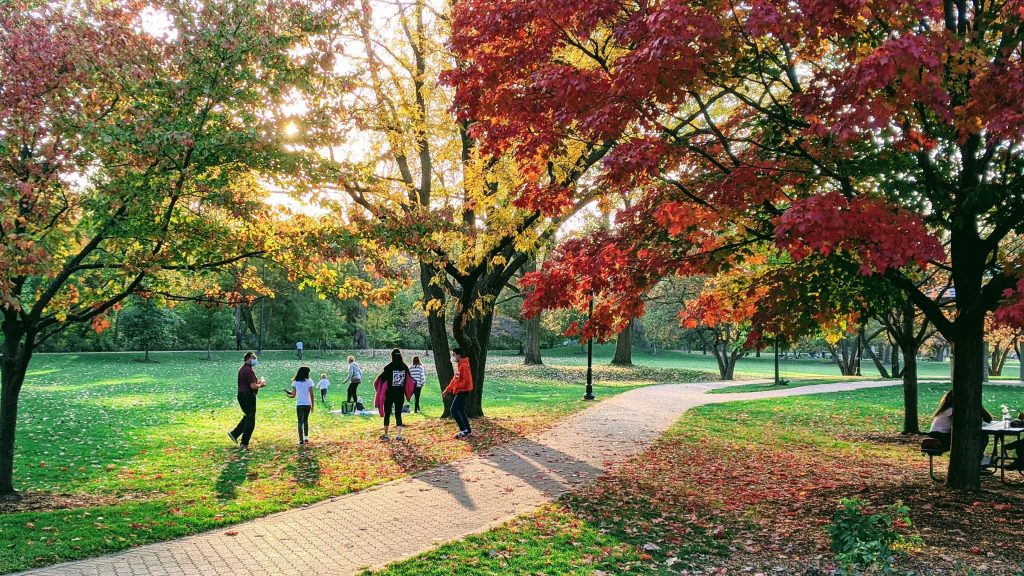
Different plants have different pigments. Other than being beautiful to look at, they fulfil extra important functions from plants. They protect them from harmful UV radiation, help to limit the damage caused by stresses such as salt and dryness, and help to attract specific animals, including humans, to consume the flowers, fruit and vegetables they can be found in!
- Anthocyanins: are water soluble pigments that depending on their pH, may appear red, purple or blue. Food plants rich in anthocyanins include blueberries, raspberries, black rice and black soybean, along with many others that are red, blue, purple or black. Some of the colours of autumn leaves are also derived from anthocyanins.
- Carotenoids: are organic pigments that are produced by plants, that tend to be coloured yellow, orange or red. These compounds are the dominant pigment in autumn leaf colouration in about 15 – 30% of tree species, but are also important in colouring the flowers of many species.
- Betalains: are pigments derived from the amino acid tyrosine. They are familiar as the colour of beetroot, but can also take yellow and orange hues. In flowering plants they are unique to the order caryophylales, which contains beetroot but also spinach, bougainvillea and cacti.
LOOK INTO THE FUTURE FOOD FORESTS
This section is connected to exercise 14 Food forests
A food forest, also called a forest garden, is a diverse planting of edible plants that attempts to mimic the ecosystems and patterns found in nature. This means that the forest is more resilient against outside influence and can take on more threats from the outside.
In contrast, in a monoculture planting of one crop, e.g corn or oats, the entire field has to be cleared for that one species to grow.
That same species is more vulnerable for pests when it stands alone, and therefore the farmer often uses pesticides.
In addition, because the crop is growing alone, all nutrients are used up in the same way and the soils nutrients can be quickly taken up. To ensure a speedier growth, the farmer often relies on external nutrients in the form of fertilizers, of which excess leaks into the waterways causing eutrophication (excess growth of algae that will cause the depletion of ogyxen of waterbodies and damage the life in the water ways).

Generally, 7 layers of food forest are recognized:
- the overstory (fruit trees, nut trees oaks, pecans
- the understory (semi dwarf fruit trees)
- shrub layer (dwarf fruit trees, hazel, serviceberry, feijoa)
- herbaceous layer (asparagus, artichoke, sage)
- root layer (root crops)
- ground cover layer strawberrry thyme, mint
- vine layer (passion, kiwi)
A food forest does not have to be re-planted year after year. Once it is established, it is generally very resilient even if it experiences some visits from e.g., rabbits, snails or deers. Even if someone would trample on a plant, majority of the plants have healthy underground systems, and they will grow back.
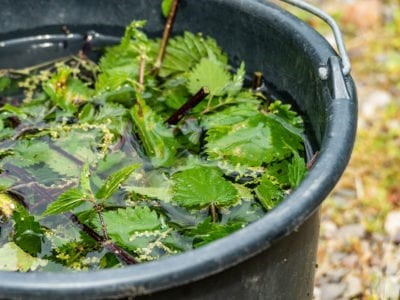
Forest garden design can reduce the workload of the caretaker because it takes care of itself. In a forest garden or food forest, annuals (plants that live only one year) are used that disperse their seeds themselves and take care of next year’s growth in this manner. Forest gardens do not have to take up a lot of space as they grow in layers and can be harvested from several heights.
The species that are planted for shading and suppressing weeds, are also edible, as are the nitrogen fixing and nutrient accumulating plants like beans and peas. It is a closed system in which the “chop and drop technique” (when pruning a healthy plant, the cuttings are dropped on the mulch layer, adding to the mulch) is used, and returning wastes to the land to create healthy soil rather than applying fertilizer which is always an addition to the system.
According to the food forest philosophy, the food forest must be organic and planted on a soil that has had the time to recover from any pesticide and herbicide using agriculture. Organic means that the in the cultivation of the crops no chemical fertilizers, pesticides, or other artificial chemicals have been used. Food forest products cannot be sprayed with herbicides or pesticides. Only organic fertilizers, such as nettle water, can be applied. This should translate to products that are more nutrition packed than products grown with fertilizers and pesticides.
Organic foods also often have more antioxidants and other nutrients. Because of the vast array of (mostly) edible plants it uses, a food forest attracts beneficial insects that pollinate the fruit crops and keeps pest populations away. The food forest does not easily dry as it utilizes techniques for ground shaping that keep rainwater on the site. Finally, it allows for flexibility in design so that plants can be placed so that they create micro-climates and windbreaks where needed.

